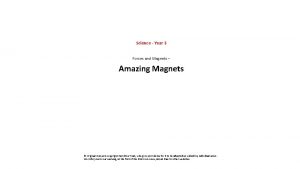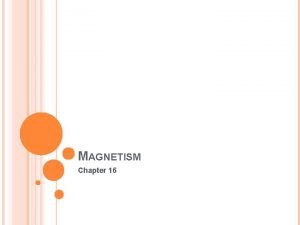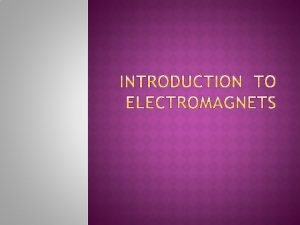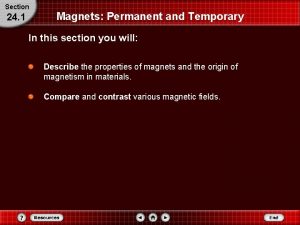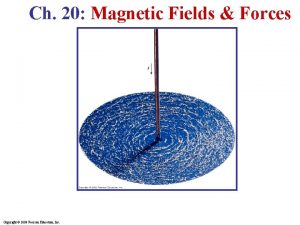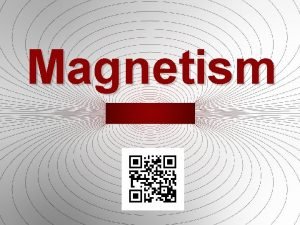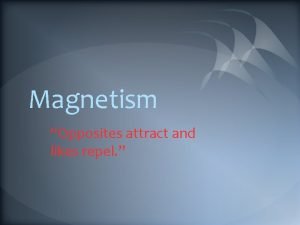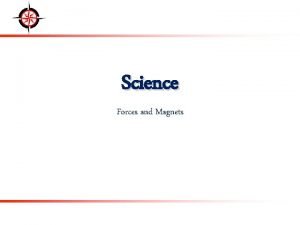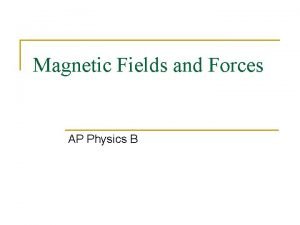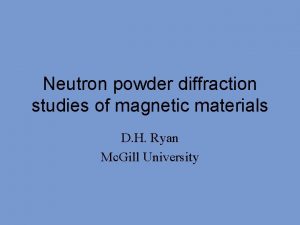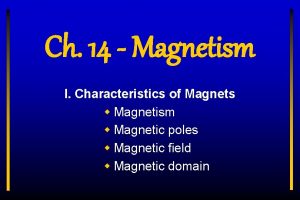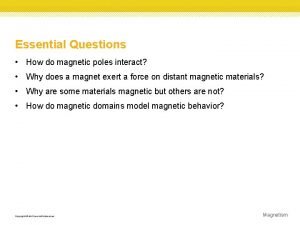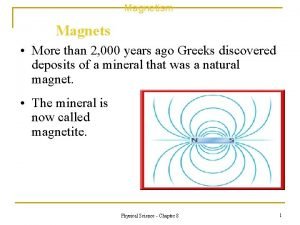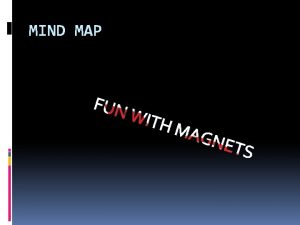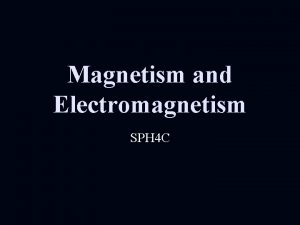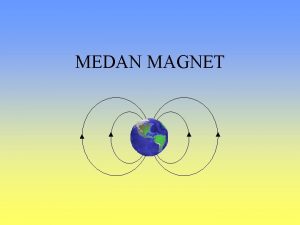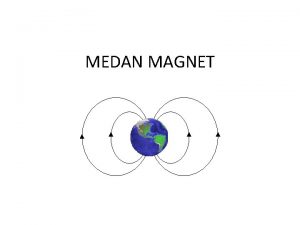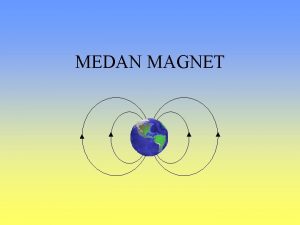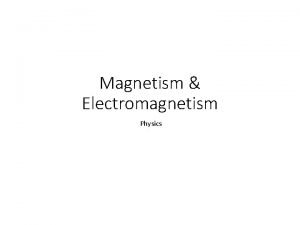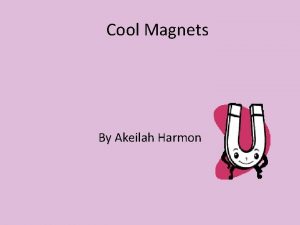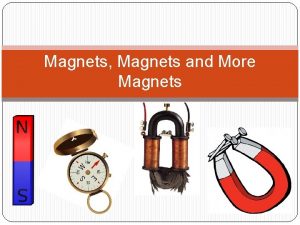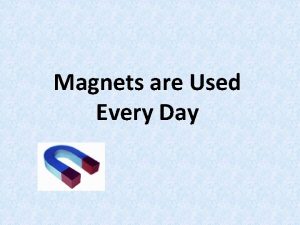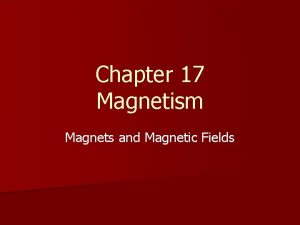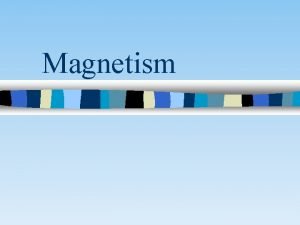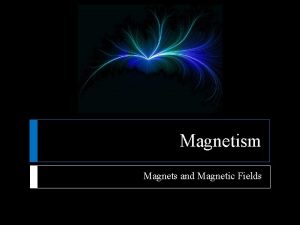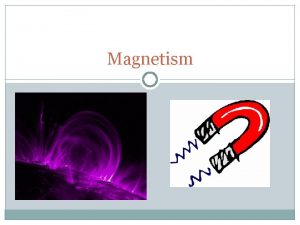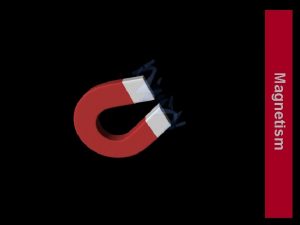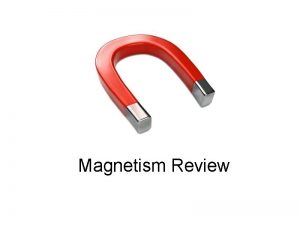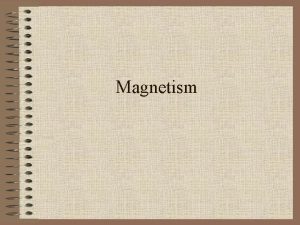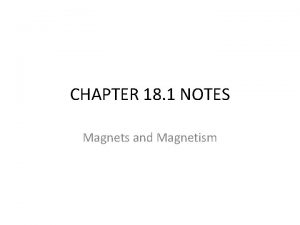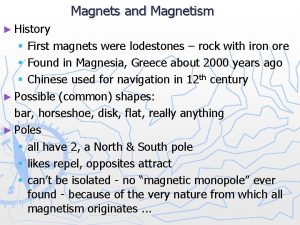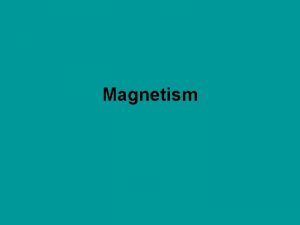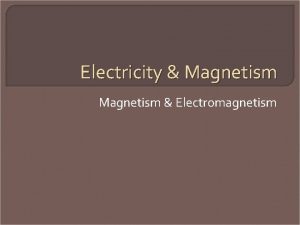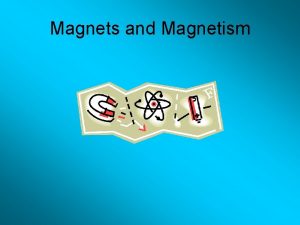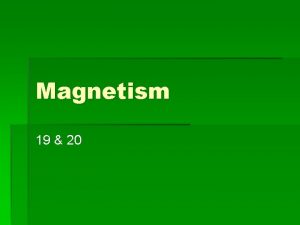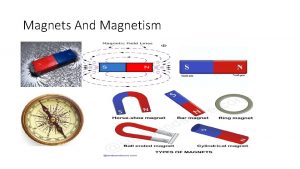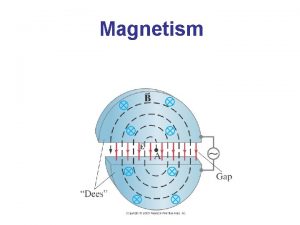Magnetism Magnets A magnet has polarity it has
























- Slides: 24

Magnetism

Magnets ► A magnet has polarity - it has a north and a south pole; you cannot isolate the north or the south pole (there is no magnetic monopole) ► Like poles repel; unlike poles attract

Magnets ► A compass is a suspended magnet (its north pole is attracted to a magnetic south pole); the earth’s magnetic south pole is within 200 miles of the earth’s geographic north pole (that is why a compass points "north")

Magnets Some metals can be turned into temporary magnets by bringing them close to a magnet; magnetism is induced by aligning areas called domains within a magnetic field ► Domains strong coupling between neighboring atoms of ferromagnetic materials to form large groups of atoms whose net spins are aligned ► Unmagnetized substance domains randomly oriented ►

Magnets ► When an external magnetic field is applied the orientation of the magnetic fields of each domain may change to more closely align with the external magnetic field ► Domains already aligned with the external field may grow at the expense of others

Magnets ► Materials soft can be classified as magnetically hard or – like iron - are easily magnetized, but lose magnetism easily once an external field is removed, the random motion of the particles in the material changes the orientation of the domains the material returns to an unmagnetized state ► Soft

Magnets ► Hard – like cobalt and nickel – difficult to magnetize, but retain their magnetism domain alignment persists after an external field is removed the result is a permanent magnet

Magnetic Fields ► The concept of a field is applied to magnetism as well as gravity and electricity. ► A magnetic field surrounds every magnet and is also produced by a charged particle in motion relative to some reference point. ►B = F____ q 0(v*sinq)

Magnetic Fields ► The direction of a magnetic field, B, at any location is defined as the direction in which the north pole of a compass needle points at that location

Magnetic Fields ► To indicate direction on paper we use the following conventions: Arrows show direction in the plane of the page X Crosses represent the tail of an arrow and show direction into the page. Dots represent the tips of arrows and show direction out of the page

Magnetic Force ►A charge moving through a magnetic field experiences a force Fmagnetic =qv(sinq)B q –magnitude of charge, in Coulombs (C) v –velocity of charge, in m/s and must have a component perpendicular to the field B –magnetic field strength, in Teslas (1 T=Ns/Cm) no magnetic force acts on a stationary charge

Magnetic Force ► Use the right-hand rule to find the direction of the magnetic force ► Magnetic force is always perpendicular to both v and B ► Place your fingers in the direction of B with your thumb pointing in the direction of v ► The magnetic force on a positive charge is directed out of the palm of your hand ► If q is negative, find the direction as if q were positive and reverse the direction

The Circular Trajectory ► Consider a positively charged particle moving perpendicular to a magnetic field ► Since the magnetic force always remains perpendicular to the velocity the magnetic force causes the particle to move in a circular path ► The force according to the RHR is directed to the center of the circular path

The Circular Trajectory ► Since Fmag = qv. B and Fc = mv 2/r then qv. B = mv 2/r and r = mv/q. B

Magnetic Fields Produced by Currents ►A current carrying wire produces a magnetic field of its own ► Discovered by Hans Christian Oersted in 1820 ► Marked the beginning of electromagnetism ► ► r radial distance μ 0 permeability of free space = 4π x 10 -7 Tm/A

Magnetic Field of a Current Carrying Wire ► The direction of this field can be determined using the right-hand rule. Grasp the wire in the right hand with your thumb in the direction of the current Your fingers will curl in the direction of the magnetic field

Magnetic Field of a Current Loop can use the right-hand rule to determine the field around a current carrying loop ► Regardless of where you are on the loop the magnetic field inside of the loop is always the same direction - upward ► You

Magnetic Field of a Current Loop ► Solenoids – produce strong magnetic fields by combining several loops of wire together are important in many applications because they act as a magnet when it carries current magnetic field can be increased by inserting an iron rod through the center of the coil creating an electromagnet

Magnetic Force on a Current. Carrying Conductor ► Current motion ► Since electricity is charged particles in charged particles moving in a magnetic field experience a force, likewise a current-carrying wire placed in a magnetic field also experiences a force

Magnetic Force on a Current. Carrying Conductor ►Fmagnetic ►B = BILsinө Magnetic field strength in Teslas (T) ► I Current ► L length of conductor within B

Magnetic Force on a Current. Carrying Conductor ► To find the direction of the magnetic force on a wire we again use the right-hand rule ► You place your thumb in the direction of the current (I) in the wire rather than the velocity (v) ► Your fingers as before are in the direction of the magnetic field B ► The magnetic force comes out of your palm

Magnetic Force on a Current. Carrying Conductor ► Current-carrying wires placed close together exert magnetic forces on each other when current runs in the same direction the wires attract one another when current runs in opposite directions the wires repel one another

Magnetic Force on a Current. Carrying Conductor ► Loudspeakers use magnetic force to produce sound ► Most speakers consist of a permanent magnet, a coil of wire and a flexible cone ► A sound signal is converted to a varying electrical signal and is sent to the coil ► The current causes a magnetic force to act on the coil

Magnetic Force on a Current. Carrying Conductor ► When the current reverses direction, the magnetic force on the coil reverses direction, and the cone accelerates in the opposite direction ► Alternating force on the coil results in vibrations of the attached cone, which produces variations in the density of air in front of it, or sound waves
 What electronegativity difference is polar
What electronegativity difference is polar Molecular shape finder
Molecular shape finder Amazing magnets fishing magnet
Amazing magnets fishing magnet What are properties of magnet
What are properties of magnet Are electromagnets permanent or temporary
Are electromagnets permanent or temporary Besi lunak diletakkan di sekitar magnet
Besi lunak diletakkan di sekitar magnet What happens if you break a magnet in half
What happens if you break a magnet in half Pearson
Pearson Magnetic field lines that curve away from each other show
Magnetic field lines that curve away from each other show Organizational magnets
Organizational magnets Sigmaphi magnets
Sigmaphi magnets Opposites attract likes repel
Opposites attract likes repel Amazing magnets
Amazing magnets Force exerted by magnets
Force exerted by magnets Facts about magnets for kids
Facts about magnets for kids Magnets for neutron diffraction
Magnets for neutron diffraction Characteristics of magnetism
Characteristics of magnetism Why do magnets repel
Why do magnets repel Why do magnets repel
Why do magnets repel Which diagram shows magnets that will attract each other?
Which diagram shows magnets that will attract each other? Mind map
Mind map Magnets for year 3
Magnets for year 3 Amazing magnets
Amazing magnets Properties and interactions of magnets
Properties and interactions of magnets What are magnets
What are magnets


